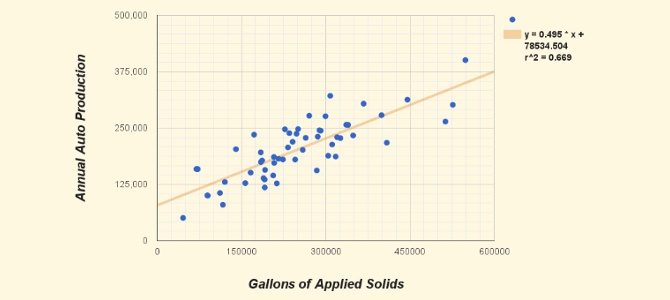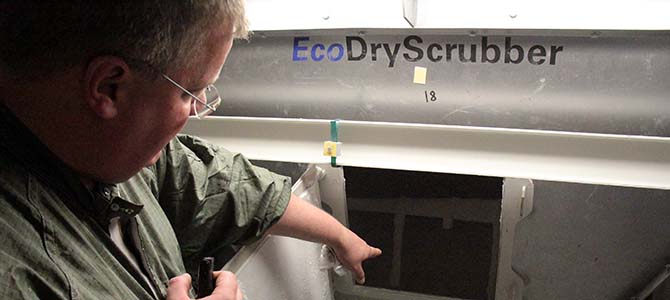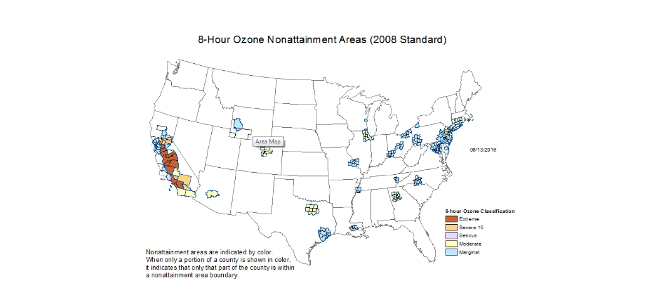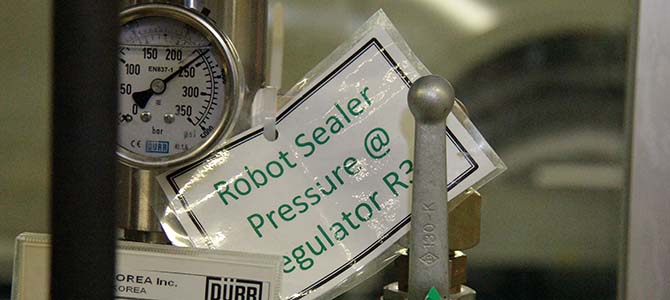
Capacity constrained: Monitors at Eisenmann paint shop in Volkswagen’s Chattanooga plant. A similar shop is at Tesla (Picture: Bertel Schmitt)
When Tesla CEO Elon Musk announced plans to produce 500,000 electric vehicles per year by 2018 and a million units per year by 2020, he set his young company on the most ambitious course of expansion the auto industry has ever seen. Without a clear historical precedent for Tesla’s meteoric trajectory and unconventional methods, it can be quite difficult to predict all the challenges this unique automaker might face or how it might approach them. Only one such challenge stands out as being as foreseeable as it is implacable: the environmental regulations that Tesla must navigate as it seeks to expand its Fremont, CA plant.
Because Tesla’s only factory is located in California’s densely-populated San Francisco Bay Area, the electric automaker’s manufacturing operations are subject to some of the toughest environmental regulations found anywhere in the US auto industry. The Daily Kanban has already reported on one instance of environmental permit non-compliance at Tesla’s Fremont plant, and our ongoing investigation in consultation with air quality permitting professionals reveals that Tesla’s unprecedented expansion plans will create equally unprecedented regulatory challenges.
The toughest environmental permitting challenge at any auto plant is the paint shop, and Tesla’s Fremont facility is no exception. The final assembly of vehicles is a relatively low-emission industrial activity, but automotive surfacing typically creates relatively high emissions of Precursor Organic Compounds (POC) or Volatile Organic Compounds (VOC) which are offgassed when a solvent is applied, dries or cures. These pollutants are regulated on the federal level by the EPA, which limits VOC content to 6 lbs per gallon of automotive coating for example, and on the state level by regulators like California’s Air Resources Board (CARB) which limits paint VOC to a significantly tougher 3.5 lbs per gallon of coating. Factories themselves are subject to Title V permits under the Clean Air Act [the Title V permit for Tesla’s Fremont plant can be found here] which limit emissions from each source (a spray booth or thermal oxidizer, for example) as well as the entire facility. Local air quality management boards, like the Bay Area Air Quality Management Board (BAAQMD) in the case of Tesla’s Fremont facility, are tasked with monitoring actual emissions and enforcing these permits.
TL;DR
- Air quality permits for the recently-upgraded paint shop at Tesla’s Fremont plant limit the electric automaker’s production capacity to less than half of its targeted rate of 500,000 vehicles per year
- Tesla says it plans a second expansion of the Fremont paint shop, but has not yet applied for the necessary emissions permit or even put the equipment from its first expansion phase into use.
- If any future expansion or upgrade increases the Fremont plant’s net emissions by more than 6.5% over currently-permitted levels, Tesla’s paint shop will be required to comply with the extremely stringent Lowest Achievable Emission Rate (LAER) standard.
- These regulatory conditions present a serious challenge to the volume goals and production ramp forecast Tesla has publicly set for Model 3
In December of 2014, Tesla applied for a permit to construct a new paint shop at its Fremont plant in order to “improve the efficiency of its paint systems” and move towards the higher production volumes needed for Model 3. This application required Tesla to describe the equipment and processes used at its new paint shop in order to prove that the upgrade and the increased rate of production it enables will not increase emissions beyond the permitted level. The copy of this application obtained by Daily Kanban was too heavily redacted to allow a precise analysis of the methods used to meet the permit standard, but the original satisfied BAAQMD regulators who issued an Authority To Construct (ATC) on July 9, 2015.
In contrast to Tesla’s heavily-redacted application, the ATC issued by BAAQMD offers a far more useful look at the nuts and bolts of the Fremont paint shop expansion. A summary of the project’s scope reveals that Tesla would be transferring some equipment (or pollution “sources”) from its South Paint Shop to its North Paint Shop, constructing new equipment at the North Paint Shop and moving other equipment from the Plastics Shop to the South Paint Shop. The granted “Authority To Construct” also required Tesla to decommission its existing South Paint Shop painting operations as part of the ATC approval. This combination of new construction and a reshuffling of existing equipment is helpfully summarized in the following section, titled “Start-Up Overlap” :
“There will be an overlap of operations between sources at the South Paint Shop and the North Paint Shop, which are the subject of this application. During the start-up operations, vehicles will be processed at new/existing/relocated sources in the South Paint Shop and the North Paint Shop. This will be done until all unforeseen problems associated with a project of this size can be resolved. This will allow Tesla to prove the operation and reliability of the new equipment and sources, without any interruptions in production. During this one-year period (as specified in the proposed permit conditions), excluding non-production trials, any vehicle produced in the North Paint Shop will not be produced in the South Paint Shop. Therefore, commercial production in the South Paint Shop will be replaced on a one to one basis, resulting in a net decrease in emissions from [a number of sources] in the South Paint Shop, until full conversion of vehicle production in the North Paint Shop is accomplished. At that point the existing sources at the South Paint Shop that are being replaced will be permanently shutdown.”
Had this project simply consisted of a new construction and not included this shuffling of existing equipment, it might have been nearly impossible to draw many conclusions about its impact on the paint shop’s capacity. But because the project included this start-up period in which both shops would be operational, BAAQMD had to create a temporary limit to prevent their combined operations from exceeding permitted emissions levels. That condition reads:
“During the start-up period, vehicles may be processed through either the South Paint Shop or North Paint Shop, as long as the total number of vehicles produced at both paint shops combined does not exceed 25 vehicles per hour.” [emphasis added]
Given the care with which Tesla redacted its application to conceal any evidence that might have revealed its production capacity is something of a bombshell. The permit proves conclusively that Tesla’s paint shop will be legally limited to 25 vehicles per hour for its first year of operation, which would work out to a maximum annual production of 219,000 vehicles per year if operated 24/7 (which paint shops realistically can’t do, given the need for regular maintenance). Since Tesla had not filed a Start-Up Notification with BAAQMD for this project at the time of publication, this condition is likely to apply to its paint shop for most or all of 2017. That makes it all but impossible for Tesla to legally reach the growth levels that Musk predicted for 2017 during the Q2 2016 call, namely that “we’ll probably exit next year at unit volume that’s 200% or 300% what our current volume is, maybe 400%.” If Tesla hits its guidance of 80,000-90,000 units produced this year, even 200% of that level in 2017 would bring Fremont’s paint shop dangerously close to its regulatory limit; anything approaching 300% or 400% volume growth next year would completely surpass it.
This year of production limits would temporarily slow Tesla’s “hypergrowth,” but what about permit limits on production rates at Fremont thereafter? According to Daily Kanban’s expert collaborator, temporary conditions like the one governing the paint shop’s “Start-Up Period” typically reflect ongoing permit limits but BAAQMD declined to confirm that this was the case in this instance. Further analysis would be required to understand the limits imposed by Tesla’s air quality permit beyond the one-year Start-Up Period.
Since neither Tesla’s application nor BAAQMD’s ATC provided a limit based on annual production volume, that number would have to be back-calculated using the limit on VOC emissions, the ratio of VOC to gallons of applied paint solids (gac) and an estimate of the amount of solids applied to each vehicle. The first two factors are included in the ATC: the combined emission limit for all of Fremont’s spray booths and associated ovens is 587.5 tons of VOC per year at a maximum rate of 4.8 lbs of VOC/gac. With these numbers, it is possible to calculate the number of gallons of paint solids Tesla is permitted to apply each year using the following formula:
Having calculated that Tesla’s permit only allows it to apply 244,584 gallons of paint solids per year, only the amount of gac per vehicle was needed to determine the permit’s limit on Tesla’s ongoing production volume. Though a specific number was not available for the Fremont plant itself, the EPA does provide data for both annual production and annual gac from a survey of 60 US auto plants conducted between 1998 and 1999 to support the development of new auto surfacing regulation. Though Tesla doesn’t make full-sized pickups and SUVs which made up a significant percentage of the industry-wide mix during the years surveyed, it also doesn’t produce compact or subcompact vehicles and its Model S sedan and Model X crossover are relatively large by 1998/9 standards, meaning its vehicle size should not be too far off from the survey average. Paint shops also don’t vary dramatically from plant to plant and surfacing techniques haven’t changed much in recent decades, making this industry data a serviceable –if imperfect– indicator for Tesla’s paint shop.
When plotted out in the chart seen below, this industry data reveals a fairly linear relationship between annual production volume and gallons of applied paint solids:
By applying the ratio of annual units of production to annual gallons of applied paint solids derived from this industry survey to Tesla’s permitted limit of 244,584 gac/year, we get roughly 200,000 units per year. Assuming that the amount of paint Tesla applies to each vehicle roughly reflects this industry average, Tesla’s new paint shop permit does indeed appear to impose an ongoing production limit that is remarkably close to the temporary 25 vehicle per hour limit set for the Start-Up Period. Even with an extremely conservative allowance for variation between the industry average and Tesla’s actual paint shop, there’s no way that Tesla’s current permit allows it to produce anything close to the planned 500,000 units per year.
Further evidence that Tesla’s currently-permitted paint shop expansion will bring its capacity to about half the hoped-for 500,000 units per year can be found by comparing it to what appears to be a remarkably similar paint shop at BMW’s Spartanburg, SC plant. In 2014 BMW added an additional paint shop at Spartanburg with the same Eisenmann Eco-scrub system that Tesla used in its paint shop upgrade shortly thereafter, possibly even using the same sources of subcontracted labor. Both the BMW and Tesla paint shops added a single new e-coat system, paint and topcoat lines and natural gas-fired ovens, yet BMW’s expansion added a maximum throughput of just 30 vehicles per hour according to Eisenmann’s press release, or 150,000 units per year when operated on a standard two-shift schedule. BMW’s Spartanburg facility now has two separate Eisenmann constructed paint shops, capable of producing a combined total of 450,000 cars a year. Though there may be enough of a difference between the two shops to give Tesla’s a higher throughput rate, the evidence once again suggests that Tesla’s paint shop is capable of half the planned 500,000 units/year capacity at the most.
During the research of this article, the Daily Kanban ran the amounts of permitted paint solids by a number of production experts of different major automakers. They all came to the conclusion that given the allowed 244,584 gallons of paint solids per year, they would feel comfortable with making something in the neighborhood of 200,000 units. They also felt better about Tesla’s sanity. “Going from 50,000 units last year to 200,000 in 2018 would be aggressive, but possible,” said one of the experts. “500,000 would be plain nuts. I am happy to hear that Tesla hasn’t lost its mind.”
Paintshop maker Eisenmann’s press release announcing the contract to upgrade Tesla’s paint shop specifically states that “Tesla plans to increase production capacity from 30,000 to 500,000 units annually in two stages.” When asked for comment on the findings of this investigation, Tesla’s only response was that it is undertaking a “phased” expansion of the Fremont paint shop. Given the wealth of evidence to suggest that Tesla’s currently-permitted expansion is limited to (at most) half of the planned 500,000 units/year capacity, it seems safe to conclude that another phase of the expansion is still to come. The obvious question, still unanswered by Tesla, is: how long will it take to bring the rest of the 500,000 units/year capacity online and how will that affect the production ramp for Model 3?
Tesla was asked to comment on these findings and was given ample time to do so. AS Tesla declined to provide details of its plans regarding the expansion of the Fremont paint shop, the questions above can only be extrapolated using publicly-available information. Roughly seven months elapsed between Tesla’s permit application in December 2014 and BAAQMD’s issuance of an authority to construct in July 2015, which roughly correlates to the amount of time required to permit similar projects according to industry sources. Construction time is more difficult to estimate, given that it is still unclear whether construction of the already-permitted first phase is even complete. A document from the City of Fremont’s Community Development Department Planning Division last updated on July 31, 2016 shows the status of Tesla’s North Paint Shop expansion project as “Open for Public Comment,” suggesting that construction was not yet completed –and may not even have officially begun– at that point. At the time of publication, Tesla still had not filed a start-up notice for its first phase of the project further suggesting that construction may still not be complete. Construction times for other automotive paint shops can vary by a matter of years, but the construction firm Gallagher Kaiser claims that its installation of GM’s Orion Assembly paint shop in just 12 months was the fastest-ever construction of a complete paint facility.
Based on these facts, a generous best-case scenario for the second phase of Tesla’s paint shop expansion appears to be about six months for permitting and another twelve months for construction. If Tesla were able to file an application by the end of this week, the soonest it could reasonably hope to complete the project is April of 2018. If construction were to take more than a year, as it may well have for the first phase of the expansion, Tesla would be without its full 500,000 units per year of paint shop capacity until the second half of 2018. Even with an application filed now, there seems to be no way to actually hit the 500,000 full year number until 2019 at the very earliest.
But even that best-case scenario faces a daunting regulatory challenge that can’t be overcome with Musk’s inventive genius or Tesla’s easy access to capital. Thanks to its location near the densely-populated San Francisco Bay Area, the Fremont plant is in an EPA-designated “non-attainment area” that makes it subject to incredibly strict level of regulations in the event of any net increase in VOC emissions of more than 40 tons per year. Tesla was able to avoid this threshold in the first phase of its paint shop expansion by decommissioning its existing paint shop and modifying other VOC emissions sources, and thus avoiding a net increase in emissions. But as it continues to expand its paint shop capacity toward its stated goals and runs out of easily-removable sources to net out the new emissions, the likelihood of hitting that 40 ton/year net VOC emission increase threshold grows to a near-certainty.
Some rough math provides a sense of easily this could happen. The ATC for Tesla’s first phase of expansion limits the entire paint shop to 603.2 tons of VOC emissions per year at a production rate of about 220,000 vehicles per year, putting its permitted VOC emissions per vehicle at about 5.5 lbs. At that rate, a production increase of just 14,600 vehicles per year –a mere 6.5% jump– would put it at the 40 tons/year emission increase threshold. Doubling production to 500,000 units/year without increasing emissions by more than 6.5% would require massive reductions in emissions elsewhere at the facility, and may not actually be possible at all. When production levels of 800,000 or a million units per year enter the conversation, levels that Musk says are “feasible” but “maybe not advisable” at Fremont, trying to solve the emissions challenge suddenly makes landing a rocket on a barge look like child’s play.
Assuming that Tesla’s “hypergrowth” ambitions can’t be endlessly offset by removing other emissions sources and the Fremont plant does eventually generate a more than 40 ton/year increase in VOC emissions… what then? Because those VOCs are regulated as ozone precursors and Alameda County is a marginal non-attainment area for 8-hour ozone, Tesla’s permitting process would be tightened from one that requires the use of “Best Available Control Technology” (BACT) to one that requires the “Lowest Achievable Emission Rate” (LAER). These regulatory categories have specific definitions and requirements for each industry, but the upshot is simple enough: BACT requires the best emission control techniques that are also technically feasible and economically reasonable, whereas LAER requires the absolute best possible control techniques regardless of the cost or complexity.
By definition, any LAER permit process is going to be dramatically more challenging and costly than a BACT permit process, but in Tesla’s case there’s yet another layer of challenge in store. Both BACT and LAER are precedent-based requirements, meaning the measures that must be taken to comply are based on what other companies in your industry have implemented in the past. So as Tesla goes through its current BACT permitting process, it uses emission control techniques that California and BAAQMD have established for other companies. If the Fremont plant became subject to LAER permitting, however, it would have to search the EPA’s RACT/BACT/LAER clearinghouse in order to discover what techniques other auto paint shops have used for LAER compliance. But if you try to search for permits issued under process code 41.002 (OEM automobile surfacing), you’ll find that no such permits exist. No auto plant in past 10 years has implemented a LAER standard for painting cars.
The LAER standards are not set once and held static; rather, they are intended to improve to more stringent requirements over time Because a recent LAER standard does not exist for auto paint shops, Tesla would actually have to develop such a standard before complying with it. If that sounds like assigning your own homework, consider that the EPA would expect such a standard to be on the cutting edge of emission control techniques and serve as a deterrent against increased pollution in populated non-attainment areas by every other automaker. This could require steps like replacing thermal oxidizers that control 95% of emissions with regenerative thermal oxidizers capable of 99% or greater control, resulting in massive cost increases. Perhaps even more importantly for Tesla which is racing to produce the car that it’s staked its future on, developing, receiving approval for and implementing a LAER standard for auto paint shops would likely take at least two years of regulatory grind.
The following steps would have to be completed prior to beginning multi-year construction of newly permitted equipment.
- Review by BAAQMD for CEQA applicability (which could add another year to the project)
- Extensive air quality impact modeling
- Technical review by BAAQMD engineering staff, a 12-18 month process at minimum
- LAER standards review by EPA, CARB
- A public comment period
- Issuance of an Authority to Construct (ATC) by BAAQMD
In light of this grim prospect, Tesla’s decision to only permit the first half of its paint shop expansion suddenly seems far more understandable (as, it must be noted, does Toyota’s decision to all but give the Fremont plant away to Tesla in 2010). If limiting production to under 250,000 units per year in the short-term is what it takes to avoid the ordeal of creating and complying with a new LAER standard, that’s a price that is eminently worth paying. And perhaps in the meantime Tesla can scrape together enough disposable emissions sources at Fremont to make the 500,000 unit per year number without bringing about regulatory Armageddon. It’s even possible that Elon Musk is pursuing a whole new plant outside of the EPA’s punishing non-attainment areas, and that he thinks he can get it online fast enough to keep Tesla’s rapid expansion plans alive.
For now, however, Tesla says only that it plans to further expand the Fremont plant’s paint shop. Absent any further informed clarifications or physics first principles analysis of the situation, we can only speculate based on the publicly-available information obtained during the course of this investigation. As more permit applications, regulatory notices or other data points emerge, Daily Kanban’s investigation will continue.











